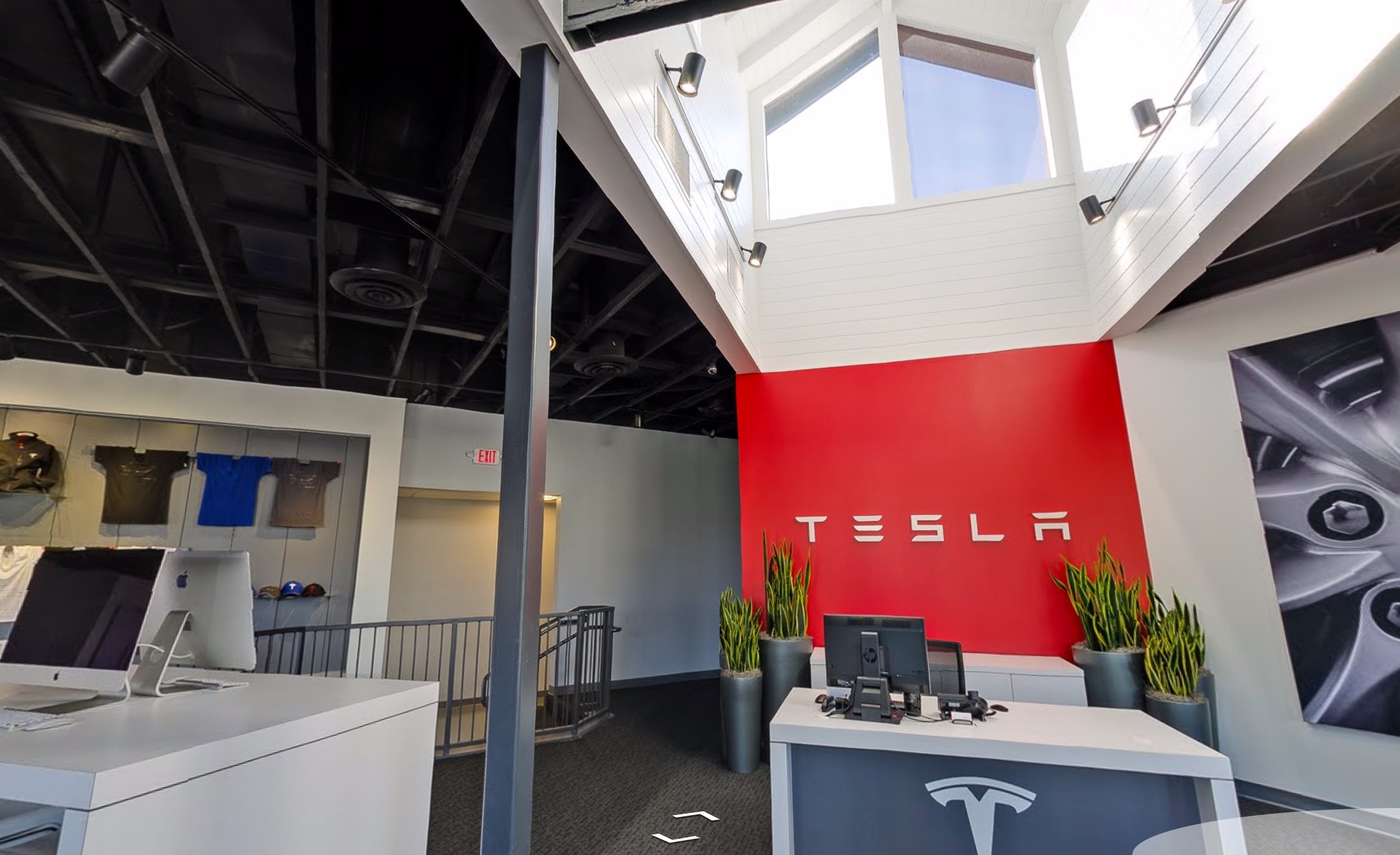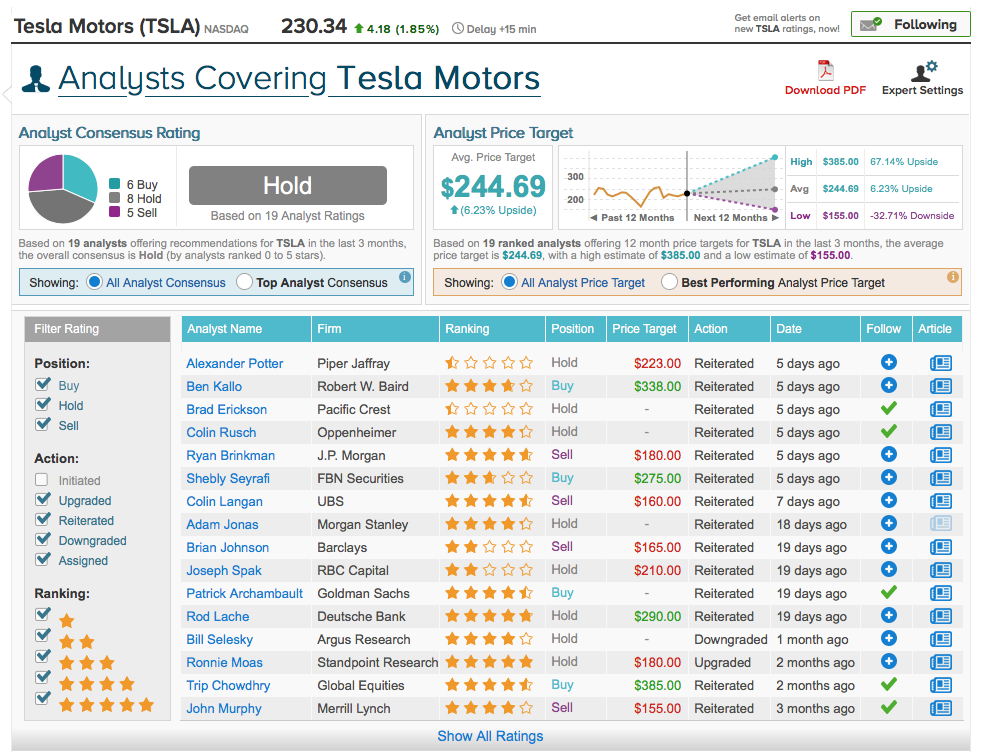Investor's Corner
Tesla stock (TSLA) one week after Q2 2016 Report

Post Q2 Report Action
As we previously reported, the Q2 quarterly results were “mixed”:
- Revenue matched expectation, a positive for Wall Street;
- Earning losses were higher than anticipated, a negative, but for a company like Tesla, where the stock price is based on future expectations, the earning numbers are really not what counts;
- Slightly increasing gross margins, a positive;
- Practically zero ZEV credits for the quarter, a negative;
- Production and demand on track to support 50,000 deliveries in 2H 2016, a positive;
- Lower production numbers than previously anticipated, a negative.
When you have such a mix of positives and negatives, it is fairly normal for traders to have a “subdued” response, unlike the usually wild responses to results that are big misses or big beats on expectations.
Accordingly, this time around the technical response of the stock market to last week’s Tesla Q2 2016 report has been “muted.” The stock has been in “compression” (a horizontal back and forth) since the report, staying in the $225-$230 range, but overall 12-month Analyst Price Targets have actually decreased with the average dropping from $277 to $244.
Looking at more details of the reactions to the report, this is a small sample from Top Analysts, noting that none of them changed their position.
Alexander Potter of Piper Jaffray says “Teslas untouchable brand helps investors look past million-dollar losses.”
“It’s hard to recommend a cash-burning company with such an uncertain outlook,” said Potter, who reiterated a neutral rating and $223 price target on the stock. But consumers and investors still seem captivated by Tesla’s products, said Potter. And as long as the company “retains this aura,” its stock multiple will “probably stay buoyant,” he said.
Brad Erickson of Pacific Crest says “The risks still outweigh the rewards.”
“Brad rattled off a number of challenges Tesla still needs to tackle in a note to clients. But he reiterated a sector weight rating on the stock, said Tesla’s cash burn wasn’t as bad as expected during the quarter, and maintained the belief that the company’s longer-term vision is “second to none.”
Ben Kallo of Robert W. Baird says “Focus [is] on Tesla (TSLA) Production Ramp and Long Term Goals, Not Q2 Miss.”
Kallo commented, “Q2 revenue was in line with our estimate, but TSLA missed on EPS with higher-than-expected OPEX. Additionally, gross margin missed consensus estimates and was pressured during the quarter with the Model S refresh and X ramp, but automotive gross margin improved sequentially, which was better than we expected. Importantly, TSLA reaffirmed its 2H:16 delivery target of ~50k vehicles, expects margins to ramp in 2H:16 given higher manufacturing efficiency, and the Model 3 remains on track for 2H:17 production.”
Kallo also covers SolarCity (SCTY) and he commented that “Although SCTY has a 45-day go-shop period which could provide additional upside, we believe it is highly likely the TSLA and SCTY merger will go through, and we are moving to the sidelines.”
Colin Rusch of Oppenheimer “noted that Tesla appears to be taking on increasing responsibility when it comes to technology development.”
“Rusch wasn’t surprised by Tesla’s quarter, and the firm remains on the sidelines until Tesla can show some progress toward profitability. It also appears to have taken a hard line with suppliers on timelines, pricing and allocation of resources,” he explained. “While we see potential benefits, we note increasing risk on supplier pushback.”
Ryan Brinkman of J.P. Morgan noted that “JPMorgan cuts Tesla estimates on higher operating expenses.”
“To reflect lower revenue and higher operating expenses following the company’s Q2 results, Brinkman cut his 2016 earnings per share estimate for Tesla to (32c) from $1.60. The analyst notes his 2016 earnings estimate was $4.62 a year ago and $2.74 at the start of this year. This reflects the “degree of consistent ratcheting down of near-term earnings,” Brinkman tells investors in a post-earnings research note. The analyst keeps an Underweight rating on Tesla with a $180 price target.”
Shelby Seyrafi of FBN Securities “reiterated a Buy rating on Tesla Motors (NASDAQ: TSLA), with a price target of $275.”
Seyrafi is a 3-star analyst with an average return of 0.5% and a 51.5% success rate. Seyrafi covers the Technology sector, focusing on stocks such as Hewlett Packard Enterprise, Dot Hill Systems Corp., and Concur Technologies.
Colin Langan of UBS, says “Tesla, SolarCity synergies still cloudy.”
“Colin noted Tesla announced details of its agreement to acquire SolarCity (SCTY) and provided synergy targets with the deal. UBS said they remain cautious on the deal given the lack of compelling synergies and the fact the deal is an unneeded distraction for Tesla management, which already faces challenges with its Model 3 launch and production targets. UBS maintained its Sell rating and $160 price target on Tesla shares.”
The overall consensus of analysts covering Tesl Motors, reported at tipranks.com, is neutral (hold).

Source: TipRanks
Trade Analysis
Quarterly Reports are usually the catalyst that start or stop actions for swing traders. The Q2 report was no different. I called for a bullish swing trade when the MACD crossed to the bulls on July 1st. The trade closed on August 4th when the MACD crossed to the bears, the day after the Q2 report was released. This was a good trade that gained over $14 in about a month period to traders that went long on the stock (see the shaded band in the chart below). For option traders this was a “fabulous” trade.
A week after the report the market is undecided on what to do with TSLA in the short term. All indicators are “neutral”: the stock has gone sideways for a week; the MACD averages are flat and overlapping; the MACD itself is at zero; both the 50-day moving average (the red line in the chart below) and the 200-day moving average (the yellow line in the chart below) are flat. All of these indicators are showing the absence of a trend. Trading in these conditions is not advisable and fairly risky. I’m personally out of trading TSLA until a trend appears.

Source: Wall Street I/O

Investor's Corner
Tesla analyst realizes one big thing about the stock: deliveries are losing importance

Tesla analyst Dan Levy of Barclays realized one big thing about the stock moving into 2026: vehicle deliveries are losing importance.
As a new era of Tesla seems to be on the horizon, the concern about vehicle deliveries and annual growth seems to be fading, at least according to many investors.
Even CEO Elon Musk has implied at times that the automotive side, as a whole, will only make up a small percentage of Tesla’s total valuation, as Optimus and AI begin to shine with importance.
He said in April:
“The future of the company is fundamentally based on large-scale autonomous cars and large-scale and large volume, vast numbers of autonomous humanoid robots.”
Almost all of Tesla’s value long-term will be from AI & robots, both vehicle & humanoid
— Elon Musk (@elonmusk) September 11, 2023
Levy wrote in a note to investors that Tesla’s Q4 delivery figures “likely won’t matter for the stock.” Barclays said in the note that it expects deliveries to be “soft” for the quarter.
In years past, Tesla analysts, investors, and fans were focused on automotive growth.
Cars were truly the biggest thing the stock had to offer: Tesla was a growing automotive company with a lot of prowess in AI and software, but deliveries held the most impact, along with vehicle pricing. These types of things had huge impacts on the stock years ago.
In fact, several large swings occurred because of Tesla either beating or missing delivery estimates:
- January 3, 2022: +13.53%, record deliveries at the time
- January 3, 2023: -12.24%, missed deliveries
- July 2, 2024: +10.20%, beat delivery expectations
- October 3, 2022: -8.61%, sharp miss due to Shanghai factory shutdown
- July 2, 2020: +7.95%, topped low COVID-era expectations with sizeable beat on deliveries
It has become more apparent over the past few quarters that delivery estimates have significantly less focus from investors, who are instead looking for progress in AI, Optimus, Cybercab, and other projects.
These things are the future of the company, and although Tesla will always sell cars, the stock is more impacted by the software the vehicle is running, and not necessarily the vehicle itself.
Investor's Corner
SpaceX IPO is coming, CEO Elon Musk confirms
However, it appears Musk is ready for SpaceX to go public, as Ars Technica Senior Space Editor Eric Berger wrote an op-ed that indicated he thought SpaceX would go public soon. Musk replied, basically confirming it.

Elon Musk confirmed through a post on X that a SpaceX initial public offering (IPO) is on the way after hinting at it several times earlier this year.
It also comes one day after Bloomberg reported that SpaceX was aiming for a valuation of $1.5 trillion, adding that it wanted to raise $30 billion.
Musk has been transparent for most of the year that he wanted to try to figure out a way to get Tesla shareholders to invest in SpaceX, giving them access to the stock.
He has also recognized the issues of having a public stock, like litigation exposure, quarterly reporting pressures, and other inconveniences.
However, it appears Musk is ready for SpaceX to go public, as Ars Technica Senior Space Editor Eric Berger wrote an op-ed that indicated he thought SpaceX would go public soon.
Musk replied, basically confirming it:
As usual, Eric is accurate
— Elon Musk (@elonmusk) December 10, 2025
Berger believes the IPO would help support the need for $30 billion or more in capital needed to fund AI integration projects, such as space-based data centers and lunar satellite factories. Musk confirmed recently that SpaceX “will be doing” data centers in orbit.
AI appears to be a “key part” of SpaceX getting to Musk, Berger also wrote. When writing about whether or not Optimus is a viable project and product for the company, he says that none of that matters. Musk thinks it is, and that’s all that matters.
It seems like Musk has certainly mulled something this big for a very long time, and the idea of taking SpaceX public is not just likely; it is necessary for the company to get to Mars.
The details of when SpaceX will finally hit that public status are not known. Many of the reports that came out over the past few days indicate it would happen in 2026, so sooner rather than later.
But there are a lot of things on Musk’s plate early next year, especially with Cybercab production, the potential launch of Unsupervised Full Self-Driving, and the Roadster unveiling, all planned for Q1.
Investor's Corner
Tesla Full Self-Driving statistic impresses Wall Street firm: ‘Very close to unsupervised’
The data shows there was a significant jump in miles traveled between interventions as Tesla transitioned drivers to v14.1 back in October. The FSD Community Tracker saw a jump from 441 miles to over 9,200 miles, the most significant improvement in four years.

Tesla Full Self-Driving performance and statistics continue to impress everyone, from retail investors to Wall Street firms. However, one analyst believes Tesla’s driving suite is “very close” to achieving unsupervised self-driving.
On Tuesday, Piper Sandler analyst Alexander Potter said that Tesla’s recent launch of Full Self-Driving version 14 increased the number of miles traveled between interventions by a drastic margin, based on data compiled by a Full Self-Driving Community Tracker.
🚨 Piper Sandler reiterated its Overweight rating and $500 PT on Tesla $TSLA stock
Analyst Alexander Potter said FSD is near full autonomy and latest versions showed the largest improvement in disengagements, from 440 miles to 9,200 miles between critical interventions pic.twitter.com/u4WCLfZcA9
— TESLARATI (@Teslarati) December 9, 2025
The data shows there was a significant jump in miles traveled between interventions as Tesla transitioned drivers to v14.1 back in October. The FSD Community Tracker saw a jump from 441 miles to over 9,200 miles, the most significant improvement in four years.
Interestingly, there was a slight dip in the miles traveled between interventions with the release of v14.2. Piper Sandler said investor interest in FSD has increased.
Full Self-Driving has displayed several improvements with v14, including the introduction of Arrival Options that allow specific parking situations to be chosen by the driver prior to arriving at the destination. Owners can choose from Street Parking, Parking Garages, Parking Lots, Chargers, and Driveways.
Additionally, the overall improvements in performance from v13 have been evident through smoother operation, fewer mistakes during routine operation, and a more refined decision-making process.
Early versions of v14 exhibited stuttering and brake stabbing, but Tesla did a great job of confronting the issue and eliminating it altogether with the release of v14.2.
Tesla CEO Elon Musk also recently stated that the current v14.2 FSD suite is also less restrictive with drivers looking at their phones, which has caused some controversy within the community.
Although we tested it and found there were fewer nudges by the driver monitoring system to push eyes back to the road, we still would not recommend it due to laws and regulations.
Tesla Full Self-Driving v14.2.1 texting and driving: we tested it
With that being said, FSD is improving significantly with each larger rollout, and Musk believes the final piece of the puzzle will be unveiled with FSD v14.3, which could come later this year or early in 2026.
Piper Sandler reaffirmed its $500 price target on Tesla shares, as well as its ‘Overweight’ rating.








